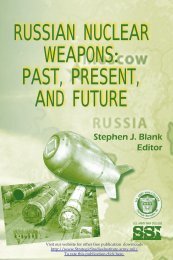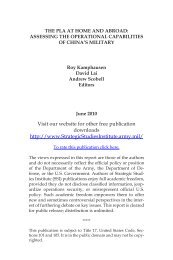The United States and China in Power Transition - Strategic Studies ...
The United States and China in Power Transition - Strategic Studies ...
The United States and China in Power Transition - Strategic Studies ...
Create successful ePaper yourself
Turn your PDF publications into a flip-book with our unique Google optimized e-Paper software.
In October 1928, the ROC government proclaimed<br />
its unification of <strong>Ch<strong>in</strong>a</strong>. Chiang Kai-shek assumed the<br />
presidency <strong>and</strong> delivered his directive that the KMT<br />
was to become an unchallenged rul<strong>in</strong>g party of the<br />
ROC <strong>and</strong> exercise authoritarian rule <strong>in</strong> <strong>Ch<strong>in</strong>a</strong> until its<br />
political, economic, <strong>and</strong> social conditions were ripe<br />
for constitutional rule.<br />
Yet by this time, the Ch<strong>in</strong>ese Communist Party<br />
(CCP), founded <strong>in</strong> 1921, had become a formidable<br />
challenger to the KMT <strong>and</strong> Chiang. <strong>The</strong> Ch<strong>in</strong>ese Communists,<br />
as one of the founders of the CCP <strong>and</strong> its<br />
eventual leader Mao Zedong (毛泽东) puts it, learned<br />
about Communism through the Bolshevik Revolution<br />
of October 1917. 21 <strong>The</strong>y believed that Communism<br />
would make a better future for <strong>Ch<strong>in</strong>a</strong> <strong>and</strong> were determ<strong>in</strong>ed<br />
to turn it <strong>in</strong>to reality.<br />
Chiang Kai-shek had no desire for the Communist<br />
idea <strong>and</strong> the Soviet model. He got a bad taste of them<br />
dur<strong>in</strong>g his “study trip” to the Soviet Union <strong>in</strong> 1923.<br />
(He was dispatched by Sun Yat-sen <strong>and</strong> is believed<br />
to have seen the dark side of Soviet communism.) He<br />
opposed Sun Yat-sen’s decision to jo<strong>in</strong> h<strong>and</strong>s with<br />
the Communists to fight for the new <strong>Ch<strong>in</strong>a</strong> <strong>and</strong> reluctantly<br />
let the Communists participate <strong>in</strong> the KMT’s<br />
Whampoa Military Academy (黄埔军校), KMT party<br />
affairs, <strong>and</strong> the Northern Expedition. With the pass<strong>in</strong>g<br />
of Sun <strong>and</strong> shortly before the conclusion of the Northern<br />
Expedition, Chiang made a “bloody split” with<br />
the Communists, kill<strong>in</strong>g many of them (the controversial<br />
“Purify<strong>in</strong>g of the Party” <strong>in</strong> the KMT’s terms, <strong>and</strong><br />
the “April 12 Tragedy of 1927” <strong>in</strong> the CCP version).<br />
He subsequently launched a campaign to purge the<br />
Communists everywhere (<strong>in</strong> violent ways).<br />
Follow<strong>in</strong>g this setback, the Communists accepted<br />
Mao Zedong’s call that “political power grows out of<br />
40

















